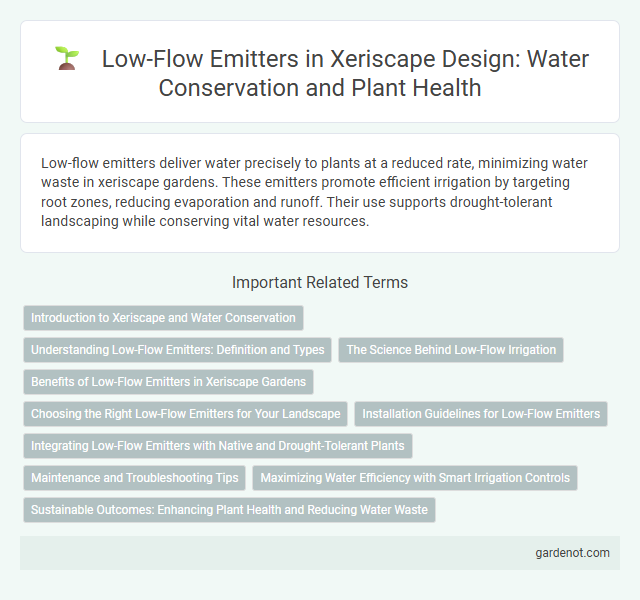Low-flow emitters deliver water precisely to plants at a reduced rate, minimizing water waste in xeriscape gardens. These emitters promote efficient irrigation by targeting root zones, reducing evaporation and runoff. Their use supports drought-tolerant landscaping while conserving vital water resources.
Introduction to Xeriscape and Water Conservation
Low-flow emitters are essential components in xeriscape irrigation systems, delivering water precisely to plant roots while minimizing waste. These devices significantly reduce water consumption by maintaining a slow, steady flow rate, which enhances soil absorption and prevents runoff. Incorporating low-flow emitters supports sustainable landscaping practices and conserves valuable water resources in dry climates.
Understanding Low-Flow Emitters: Definition and Types
Low-flow emitters are irrigation devices designed to deliver water at a slow and precise rate, typically ranging from 0.5 to 4 gallons per hour, promoting water conservation in xeriscape landscaping. Common types include pressure-compensating emitters, which maintain consistent flow regardless of pressure fluctuations, and non-pressure-compensating emitters, which vary output based on system pressure. Understanding these types helps optimize efficient water distribution to drought-resistant plants, reducing waste and supporting sustainable xeriscape practices.
The Science Behind Low-Flow Irrigation
Low-flow emitters deliver water at precise, minimal rates, enhancing xeriscape irrigation efficiency by reducing runoff and deep percolation losses. These emitters rely on hydraulic engineering principles to maintain consistent pressure and flow, ensuring optimal root zone moisture without overwatering. By optimizing water distribution patterns, low-flow emitters support sustainable landscaping and conserve valuable water resources in arid environments.
Benefits of Low-Flow Emitters in Xeriscape Gardens
Low-flow emitters significantly reduce water waste by delivering precise, slow-release irrigation directly to plant roots in xeriscape gardens. This targeted watering method enhances water efficiency, minimizes runoff, and promotes healthier plant growth in arid environments. Utilizing low-flow emitters helps conserve water resources while maintaining vibrant, drought-tolerant landscapes.
Choosing the Right Low-Flow Emitters for Your Landscape
Selecting the right low-flow emitters for xeriscape landscapes involves considering emitter flow rates, typically ranging from 0.5 to 4 gallons per hour, to match specific plant water needs while promoting water efficiency. Drip emitters with pressure-compensating features ensure consistent water delivery across varying elevations and landscape zones, optimizing irrigation uniformity. Incorporating adjustable emitters allows precise control over water distribution, reducing runoff and conserving resources in drought-prone areas.
Installation Guidelines for Low-Flow Emitters
Low-flow emitters require careful placement within xeriscape irrigation systems to ensure efficient water distribution directly to plant root zones. Installation guidelines recommend spacing emitters based on plant water needs and soil type, typically positioning them 6 to 12 inches from the plant base to prevent runoff and evaporation. Proper system pressure regulation and regular maintenance checks enhance emitter performance and longevity, optimizing water conservation in drought-tolerant landscapes.
Integrating Low-Flow Emitters with Native and Drought-Tolerant Plants
Low-flow emitters deliver precise, minimal water directly to the root zones of native and drought-tolerant plants, reducing water waste and promoting deep root growth essential for xeriscape success. Their integration ensures consistent moisture levels without oversaturation, supporting plant health while conserving valuable water resources. Utilizing low-flow emitters in xeriscape landscapes enhances irrigation efficiency and sustains the natural resilience of drought-adapted flora.
Maintenance and Troubleshooting Tips
Low-flow emitters require regular inspection to prevent clogging from soil or debris, which can disrupt water distribution and reduce irrigation efficiency. Flushing emitters periodically and using filter screens helps maintain optimal flow rates and prolongs emitter lifespan. If uneven water output occurs, checking for damage or replacing faulty emitters ensures consistent performance in xeriscaping irrigation systems.
Maximizing Water Efficiency with Smart Irrigation Controls
Low-flow emitters deliver precise amounts of water directly to plant roots, significantly reducing water waste in xeriscape designs. Integrating these emitters with smart irrigation controls optimizes watering schedules based on real-time data such as soil moisture and weather conditions. This combination enhances water efficiency, promotes healthier plant growth, and lowers overall water consumption in drought-prone landscapes.
Sustainable Outcomes: Enhancing Plant Health and Reducing Water Waste
Low-flow emitters deliver precise water amounts directly to plant roots, promoting optimal hydration and minimizing evaporation losses. This targeted irrigation method supports sustainable landscaping by enhancing plant health, reducing water consumption by up to 50%, and preventing overwatering-related diseases. Implementing low-flow emitters aligns with xeriscape principles, maximizing water efficiency while maintaining vibrant, resilient plant growth.
Low-flow emitter Infographic

 gardenot.com
gardenot.com